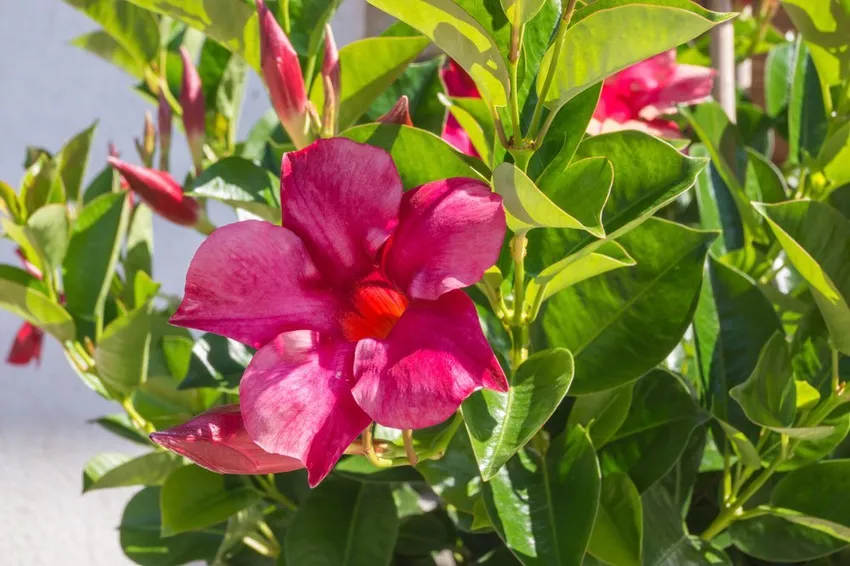If you want to get your Diplandenia through the winter unscathed, you should find suitable winter quarters in good time. But beware - there are a few things to consider here.

Initially Dipladenia (Mandevilla) were only cultivated as indoor plants. This happened with good reason, because the plants come from the tropics of South America and do not tolerate cold. In the meantime, however, it has become common practice to cultivate the plants on balconies and terraces. During the summer months, the floriferous exotics also have the climatic conditions for outdoor cultivation in our latitudes. Robust and vigorous hybrids were bred. However, there are a few things to keep in mind when overwintering the otherwise easy-care plant.
Creating optimal conditions
The most important prerequisites for the successful overwintering of Dipladenia:
- light
- warm
- frost-free
- watering little
The tropical plant not only does not like frost, it should move indoors in late summer to overwinter. At night, temperatures can drop below seven degrees in early September and there is a risk that the plant will be damaged.
Winter Mandevilla - what temperatures are optimal?
 For plants that have spent the summer on the balcony or terrace, the temperature in the winter quarters should be 10 to a maximum of 15 degrees. If the plant is warmer, it will produce only a few flowers in the following year or there will be no flowers at all.
For plants that have spent the summer on the balcony or terrace, the temperature in the winter quarters should be 10 to a maximum of 15 degrees. If the plant is warmer, it will produce only a few flowers in the following year or there will be no flowers at all.
» Tip: Species cultivated as houseplants all year round do not necessarily have to change location in winter and can continue to be cultivated at room temperature. Indoor plants are usually sufficiently adapted and the warmer winter conditions have no effect on flowering.
Overwinter Dipladenia - the best location
- As an evergreen plant, the Dipladenia will not shed its leaves even in winter and therefore needs a light location.
- However, the plants must be protected from direct sunlight.
- TooThe plants do not tolerate drafts in their winter location.
- If the plant is too dark, horny shoots appear, which deprive the Mandevilla of the power to flower.
Water and nutrient requirements in winter
In winter the plant takes a break. The growth is almost completely stopped. As early as August, the Dipladenia is no longer fertilized so that it can prepare for the dormant phase in the coming months and there is no budding caused by over-fertilization, which robs the plant of the strength to develop buds.
The Mandevilla is watered moderately. However, the soil should not dry out completely even in winter. Avoid waterlogging. This is made easier if a drainage made of potsherds is placed in the planter before planting.
» Tip: Poor maintenance in winter makes the Dipladenia susceptible to diseases and pests. The plants must therefore be checked regularly.
Overwintering Dipladenia - overview of measures
| Location | » A light location is important for the evergreen plant. » The temperatures should be between 10 and 15 degrees. » The Dipladenia should be protected from direct sunlight in winter. » The plant also does not like drafts or dry heating air. |
| Watering and fertilizing | » Watering continues in winter, but less than during the growth phase. » The soil should not dry out completely. » In the winter quarters, the plant does not receive any fertilizer because it is in the dormant phase and cannot process any nutrients. |
| Maintain | » Further care measures are not necessary. » It is advantageous to regularly check the plant for pests and diseases, which tend to occur during the winter months. |
Avoid care mistakes in winter
Dipladenia are quite robust and easy-care plants. Diseases and pests tend to be the exception. Mistakes in maintenance during the winter months are the most common cause of fungal diseases and pest infestations.
Yellow leaves - what now?
If yellow leaves appear on the plants in the winter quarters, the problem is usually to be found in the location. The yellowing of the leaves can indicate that the winter conditions are too cool. Due to the great diversity of species, there can also be different demands on the temperature. A slightly warmer location can usually helpcreate. If the leaves lose their shape and begin to curl up, the plant may be in too bright a location.
Detecting and preventing fungal and pest infestations
In general, it is important to check the plants in the winter quarters frequently. Fungi and pests can appear if the Dipladenia is too damp or suffers from a lack of fresh air.
Pests can occur:
- Aphids
- spider mites
- scale insects
- Mealybugs
If the infestation is detected in time, treatment with a water jet can have an effect. Aphids can also be treated quite easily with household remedies such as nettle broth or onion lye. If the infestation is detected too late, a commercially available pesticide must usually be used.
<» Achtung: Infected plants should be isolated to prevent other indoor plants from being infected.
Winter is coming to an end - what now?
When winter is drawing to a close, the Mandevilla will indicate this by the appearance of new shoots. Now the plant can move to a warmer location and slowly prepare for the summer - on the balcony and terrace. A little more is poured again and with the formation of new shoots, the fertilization of the plants can be resumed. The administration of liquid fertilizer at 14-day intervals promotes flowering. The ice saints should be awaited until the Dipladenia can finally move outdoors.